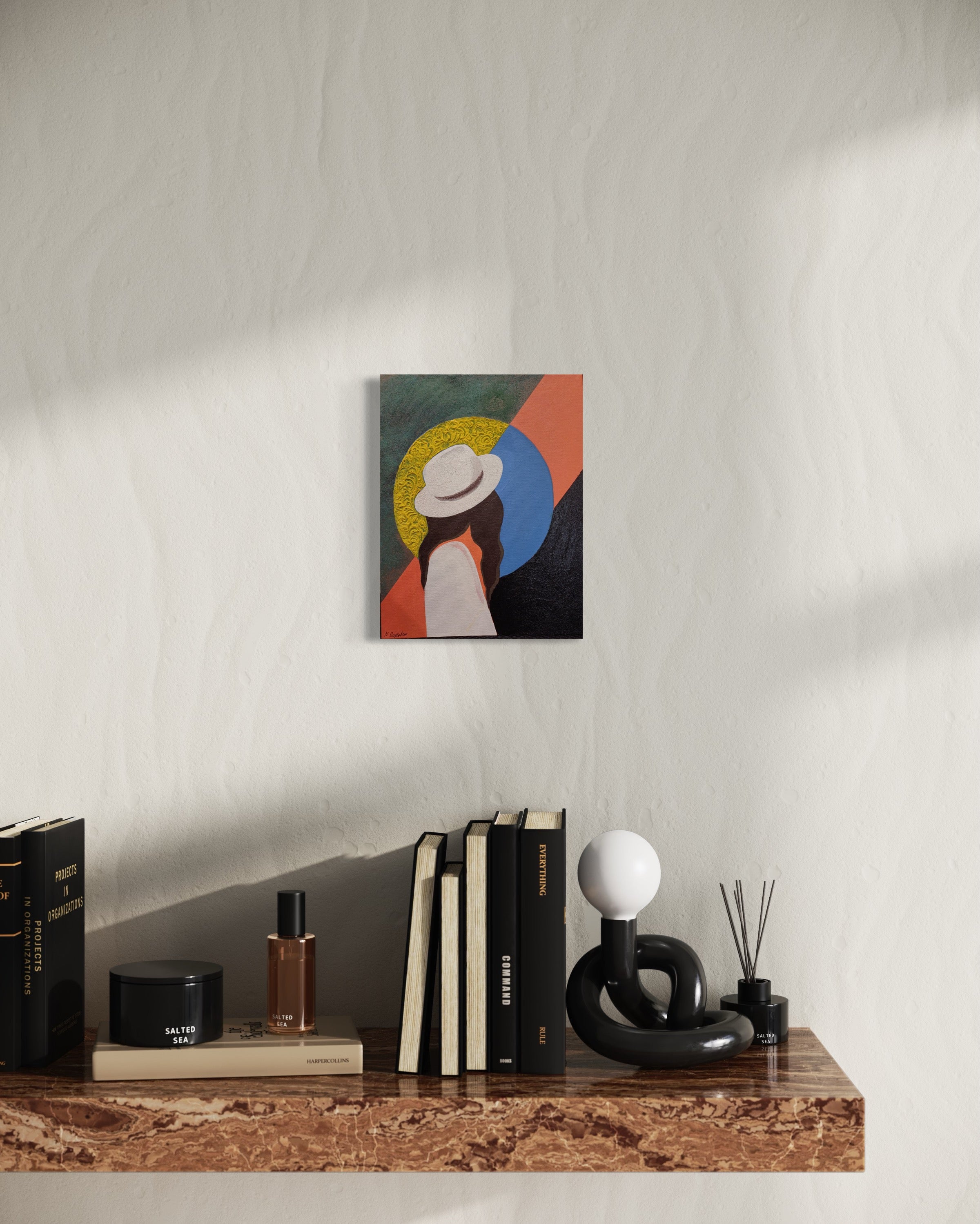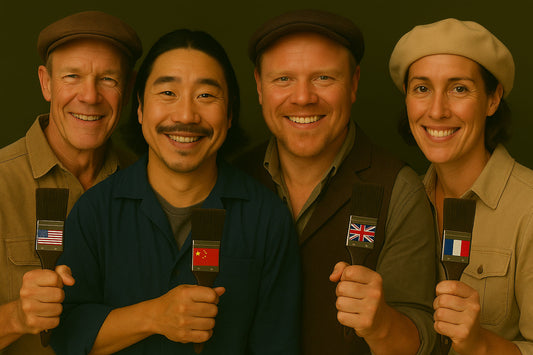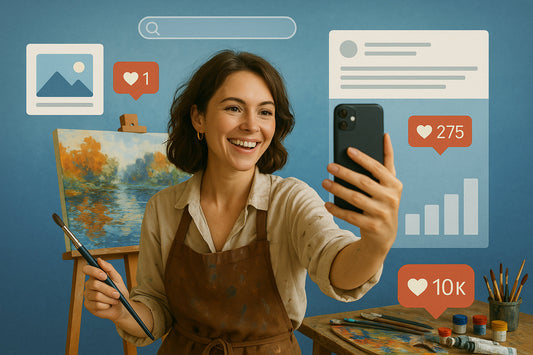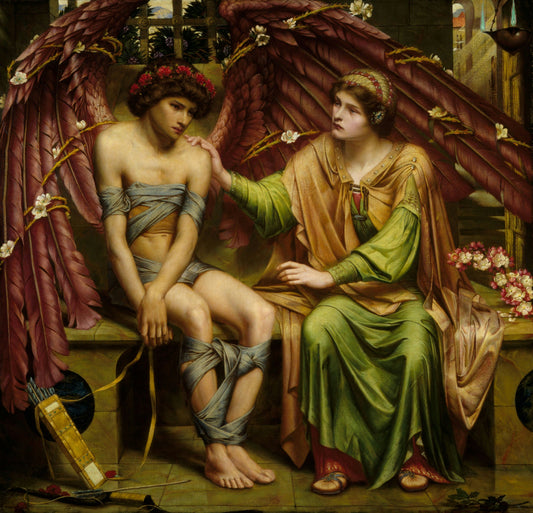Exploring Trends and Technologies Shaping the Art Market
The art market has undergone a significant transformation over the past decade, primarily driven by the digital revolution. This shift has redefined how art is created, viewed, and sold, with social media emerging as a pivotal platform in this new era. Traditionally, artists relied on galleries and exhibitions to showcase and sell their work, limiting their audience to those who could physically visit these venues. However, the advent of digital tools and platforms has democratized access to art, enabling artists to reach a global audience with just a few clicks.
The migration to online sales was accelerated by the global pandemic, which forced galleries to shut down and art fairs to cancel, pushing artists to explore alternative avenues for selling their work. Social media platforms, already a hub for creative expression, became vital sales channels. Today, platforms like Instagram, Facebook, TikTok, and others are not just tools for marketing but are integral to the business models of countless artists worldwide. These platforms offer not only a vast potential audience but also unique tools for engaging directly with buyers, collectors, and art enthusiasts.
This article explores the evolving landscape of selling art on social media, examining current trends, challenges, and future predictions. By delving into how artists utilize these platforms, the integration of new technologies, and expert insights on future trends, we aim to provide a comprehensive overview of what the future holds for artists navigating this digital marketplace.
The Rise of Social Media as a Marketplace
The transformation from traditional art sales channels to digital platforms has been both rapid and revolutionary. Social media, once seen primarily as a tool for personal expression and networking, has evolved into a dynamic marketplace for artists. This shift is not just changing where art is sold, but also how it is consumed and valued.

Photo by Antoni Shkraba
Historical Perspective
Traditionally, the art market was dominated by physical galleries and auction houses. Artists needed representation by galleries to gain recognition and sell their works, often facing high barriers to entry. The gallery system also tended to favor established artists, making it difficult for emerging talents to break through. Auction houses, while offering another avenue for sales, were similarly exclusive, dealing primarily with high-value pieces.
Digital Transformation
The rise of the internet began to change this dynamic, with websites initially serving as digital catalogues. However, the real shift occurred with the advent of social media platforms. These platforms changed the art market in several significant ways:
1. Accessibility: Artists can now bypass traditional gatekeepers and reach audiences directly. This democratization has allowed more artists to showcase their work without the need for gallery representation.
2. Global Reach: Social media platforms have a global user base, providing artists with the opportunity to reach international audiences. This has been particularly transformative for artists in remote or underserved regions.
3. Interactive Sales: Unlike traditional galleries where the interaction is often limited to viewing, social media allows for more interactive engagement. Artists can receive immediate feedback, conduct live sessions, and engage with followers in real-time, creating a more dynamic sales process.
4. Diversified Revenue Streams: Social media enables artists to diversify their income. Beyond selling original works, artists can sell prints, merchandise, and even digital versions of their art. Platforms like Instagram and Facebook have integrated shopping features that streamline the purchasing process.
Statistical Insights
The numbers highlight the growing importance of social media in the art world. A recent survey revealed that over 60% of art sales among independent artists now originate from social media channels. Furthermore, platforms like Instagram report that over 80% of their users follow at least one artist or creative business, underscoring the platform's role as a hub for art discovery and acquisition.
Case Studies
Several artists have risen to prominence largely through their social media presence. For instance, a digital artist began sharing their work on Instagram and gained international recognition, leading to collaborations with major brands and exhibitions in prestigious galleries. Similarly, an artist specializing in traditional painting used Facebook to reach out to local communities and eventually expanded their reach globally, significantly increasing their sales and exposure.
These examples illustrate the profound impact that social media has had on the art market, providing artists with unprecedented opportunities to build careers independently.
Current Trends in Selling Art on Social Media
As social media platforms evolve, so do the strategies artists employ to sell their work. This section delves into the current trends that are shaping how artists use these platforms to engage with audiences and promote their art.

Getty Images
Platform Diversity
Different social media platforms cater to various aspects of art promotion and sales, each offering unique tools and audience demographics:
- Instagram: Known for its visual format, Instagram is ideal for artists looking to showcase their portfolios. Features like Instagram Stories, Reels, and IGTV allow artists to create dynamic content ranging from behind-the-scenes videos to time-lapse creations of their artwork. The platform's integrated shopping features also facilitate direct sales.
- Facebook: While similar to Instagram in its ability to showcase visual content, Facebook provides a broader toolset for community building, including groups and events. This platform is particularly effective for artists looking to create more in-depth interactions with their followers.
- TikTok: A newer player in the social media landscape, TikTok offers tremendous reach, especially among younger audiences. Artists use this platform to share short, engaging videos that often go viral, boosting their visibility exponentially.
- Pinterest: Pinterest serves as a source of inspiration for millions, making it a valuable tool for artists to display their work to those looking for creative ideas. The platform's 'Pin' feature allows users to save ideas and later return to them, which can drive consistent traffic to artists' profiles.
Engagement Strategies
Engaging with the audience is crucial for conversion from viewer to buyer. Artists have developed various strategies to enhance engagement:
- Live Demonstrations and Q&A Sessions: Many artists use live features on platforms like Instagram and Facebook to host real-time demonstrations of their work process or Q&A sessions. This interaction not only builds a deeper connection with the audience but also gives the artist a platform to explain the value and story behind their work.
- User-Generated Content and Contests: Encouraging followers to create content related to their art or participate in contests can significantly increase engagement and reach. This form of interaction fosters a community around the artist's work.
- Exclusive Offers and Limited Editions: Offering exclusive content or limited edition pieces can create a sense of urgency and exclusivity, encouraging followers to make purchases.
Content Personalization
Personalization has become a key trend in digital marketing, and artists on social media are no exception. By utilizing data analytics provided by these platforms, artists can tailor their content to the preferences of their followers, improving engagement and increasing the likelihood of sales.
Innovative Use of Ads
Social media platforms offer sophisticated advertising tools that allow artists to target specific demographics. Successful artists often use these tools to reach potential buyers based on interests, behaviors, and previous interactions with similar content.
Collaborations and Cross-Promotions
Collaborations with other artists or brands can significantly extend an artist's reach. Cross-promotions involve sharing each other's work to mutual audiences, often sparking interest from new segments of potential buyers.
Challenges Faced by Artists
While social media provides numerous opportunities for artists to showcase and sell their art, it also presents several significant challenges. Understanding these obstacles is crucial for artists aiming to optimize their online presence and sales strategies effectively.
Market Saturation
One of the most prominent challenges faced by artists on social media is the sheer volume of competition. With millions of artists turning to these platforms to sell their work, standing out in a crowded market becomes increasingly difficult. This saturation can dilute individual visibility, making it hard for even exceptionally talented artists to gain the attention they deserve.
- Differentiation Strategies: Artists can overcome this by developing a unique brand identity or niche. This might include focusing on a specific style, medium, or theme that distinguishes their work from others. Storytelling through content can also enhance their unique selling proposition.
Algorithm Dependence
Social media platforms are governed by algorithms that determine which content appears in user feeds. These algorithms often favor content that generates high engagement, which can disadvantage artists whose work does not immediately attract likes, comments, or shares.
- Algorithm Adaptation Strategies: To combat this, artists must stay informed about changes to platform algorithms and adapt their content strategy accordingly. This might include optimizing posting times, using effective hashtags, or engaging more actively with followers to boost interaction.
Copyright Concerns
The digital nature of social media makes artwork particularly susceptible to copyright infringement. Art can be easily downloaded, reproduced, and shared without proper attribution or compensation to the original artist.
- Protection Measures: Artists can address these concerns by using watermarks, sharing lower-resolution images, or using software that tracks and manages copyright infringements. Additionally, educating followers about the importance of respecting copyright can help mitigate unauthorized use.
Economic Insecurity
Relying solely on social media for sales can be economically unstable. Algorithm changes, platform policies, or shifts in user behavior can all impact an artist's ability to generate consistent income.
- Diversification: To manage this risk, artists are encouraged to diversify their revenue streams. This might include using multiple platforms, selling through their own websites, offering workshops, or pursuing commercial partnerships.
Mental Health Impacts
The pressure to maintain a constant online presence and the emotional toll of dealing with fluctuating engagement and sales can affect artists' mental health. The demand for new content and the often impersonal nature of online interactions can lead to burnout.
- Mental Health Strategies: It's important for artists to set boundaries around their social media use, prioritize offline activities, and seek professional help if needed. Building a supportive community with other artists can also provide emotional support and practical advice.
Emerging Technologies and Their Impact on Art Sales
The integration of emerging technologies into social media platforms is dramatically reshaping the way art is marketed, sold, and experienced. This section explores key technologies that are influencing the art market and how artists can leverage these advancements to enhance their sales and audience engagement.

(Image: Getty Images)
Augmented Reality (AR) and Virtual Reality (VR)
AR and VR technologies are revolutionizing the art world by allowing artists to create immersive experiences that extend beyond traditional media. These technologies enable potential buyers to visualize artworks in their own space before making a purchase, which can significantly reduce the hesitation associated with buying art online.
- Virtual Galleries: Artists and galleries are creating virtual spaces where visitors can explore artworks as if they were physically present. This not only enhances the buying experience but also reaches a global audience without geographical limitations.
- AR Filters and Apps: Social media platforms like Instagram have incorporated AR filters, which artists use to create interactive versions of their work. These can be particularly engaging for followers, creating a unique connection with the artwork.
Blockchain Technology
Blockchain technology, primarily through Non-Fungible Tokens (NFTs), has opened new avenues for artists to monetize their work. NFTs ensure the authenticity and ownership of digital artworks, which can be a significant advantage in a market flooded with reproductions.
- Smart Contracts: These are self-executing contracts with the terms directly written into code. Artists can use smart contracts to automatically receive royalties whenever their artwork is resold, providing a continuous revenue stream that was difficult to secure in traditional markets.
- Decentralized Marketplaces: Blockchain enables the creation of decentralized art marketplaces, reducing the need for intermediaries and allowing artists to retain a larger share of the profits.
Artificial Intelligence (AI)
AI is transforming art creation, curation, and sales. It provides tools that can analyze consumer behavior, predict market trends, and personalize recommendations, thereby enhancing the marketing effectiveness of artists on social media.
- Predictive Analytics: By analyzing data from social media interactions and previous sales, AI can help artists understand which types of artworks are likely to sell, optimal pricing strategies, and the best times to release new works.
- AI in Creation: Some artists are using AI to collaborate in the creative process, generating new pieces that blend human creativity with algorithmic complexity, thus attracting a niche market interested in tech-driven art.
Case Studies
Several artists and galleries have effectively used these technologies to expand their market reach and enhance user engagement:
- A VR art exhibition allowed users from around the world to explore a curated collection of 3D sculptures and digital paintings, leading to an increase in sales and international exposure.
- An artist used blockchain to sell limited edition digital prints as NFTs, ensuring each piece remained unique and its provenance verifiable, which significantly increased their value.
Future Predictions and Trends in the Art Market on Social Media
As we look toward the future, several trends are likely to dominate the landscape of selling art on social media. These trends not only reflect the ongoing evolution of technology but also significant shifts in consumer behavior and market dynamics. Understanding these can help artists and galleries anticipate changes and adapt their strategies accordingly.
Increased Integration of E-Commerce and Social Media
Social media platforms are continuously enhancing their e-commerce capabilities to facilitate direct sales within their interfaces. This trend is expected to grow, with more integrated shopping features becoming commonplace. These enhancements will make the purchase process more seamless for buyers and potentially increase sales for artists.
- Social Commerce Innovations: Features like Instagram's Shop and Facebook Marketplace are set to evolve, offering more sophisticated tools for artists to sell their work directly through these platforms.
Personalization and AI-Driven Curation
As AI technology advances, so too will the personalization of user experiences on social media. Platforms will likely employ more sophisticated AI algorithms to curate content that aligns with individual user preferences, helping artists target potential buyers more effectively.
- Customized Viewing Experiences: Future platforms might offer highly personalized feeds that suggest art based on users' previous interactions, similar to how streaming services recommend movies and TV shows.
Sustainability and Ethical Consumerism
There is a growing trend towards sustainability and ethical consumerism in all sectors, including the art market. Consumers are increasingly aware of the environmental and social impact of their purchases and are looking for art that aligns with these values.
- Eco-friendly Art Materials: Artists might promote works made from sustainable materials or using eco-friendly practices, appealing to environmentally conscious buyers.
- Social Impact Art: Art that addresses social issues or supports charitable causes can also attract buyers looking to make a difference through their purchases.
Expansion of NFTs and Digital Art
The NFT boom has introduced many to the concept of owning digital art, and this trend is likely to expand beyond current boundaries, encompassing more types of digital assets and perhaps creating new forms of art.
- Hybrid Art Forms: The future might see a blend of traditional and digital art forms, where physical artworks are sold along with digital experiences or enhancements encoded as NFTs.
Globalization of the Art Market
Social media has already made the art market more global, but future trends suggest an even greater expansion. Artists from any part of the world will have the opportunity to reach international audiences more easily, which could lead to a more diverse and inclusive art market.
- Cross-Cultural Collaborations: As barriers continue to diminish, expect to see more collaborations between artists from different cultural backgrounds, enriching the global art scene.
Conclusion
The future of selling art on social media channels promises a landscape rich with innovation, expanded access, and evolving consumer interactions. As digital platforms continue to evolve, they offer artists unprecedented opportunities to showcase their work to a global audience, bypass traditional gatekeepers, and engage directly with their buyers. The integration of emerging technologies like AR, VR, blockchain, and AI not only enhances the art buying experience but also provides artists with powerful tools to manage their careers and creative output.
However, the path is not without its challenges. Market saturation, algorithm changes, copyright issues, and the need for economic stability are all factors that require careful navigation. Artists must remain adaptable, continuously learning and evolving their strategies to utilize these platforms effectively.
Looking forward, the trends indicate a move towards more integrated e-commerce experiences, increased personalization through AI, a focus on sustainability, and a greater embrace of digital art forms, including NFTs. These shifts will likely catalyze further changes in how art is created, valued, and sold.
Ultimately, the convergence of art and technology on social media will continue to democratize the art market, making it more accessible and inclusive. This dynamic future will not only benefit artists but also art enthusiasts and collectors, providing a richer, more connected art experience that transcends traditional boundaries.
As we embrace these changes, the art community—artists, collectors, galleries, and enthusiasts alike—must engage with these platforms thoughtfully and creatively to realize the full potential of the digital age in art commerce.





